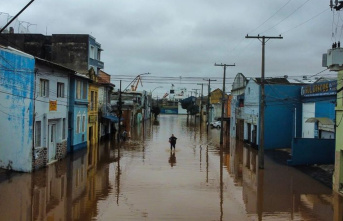Porto Alegre, the capital of Rio Grande do Sul, was completely flooded, according to aerial photos. Streets were flooded and the roofs of some houses were barely visible. The Guaiba River flowing through the city reached a new high of over five meters, according to local authorities - well above the previous record of 4.7 meters set in 1941.
The water increasingly penetrated the city of 1.4 million inhabitants and threatened hundreds of other places. In addition to the hundreds of thousands of residents forced to leave their homes due to the floods, more than a million people had no access to drinking water, according to Brazilian Civil Defense.
Porto Alegre's mayor Sebastião Melo called on people on the online service X to leave their homes. They would also have to ration drinking water after four of the city's six treatment plants failed.
"Thursday night the water started rising quickly," 37-year-old nurse Rosana Custodio told AFP. "My husband put our two little ones in a kayak and rowed with a bamboo pole. My son and I swam to the end of the street." Her family was safe but had lost everything, she said. 15,000 people in the state have so far found refuge in government emergency shelters.
Although the rain eased on Saturday, experts estimated it could continue for another 24 to 36 hours. They also warned of landslides. The authorities continued to try to evacuate flooded parts of the city. Rescue workers used four-wheel-drive vehicles and jet skis to search for stranded people in waist-deep water.
In many places, long queues formed in front of the few remaining buses - due to the floods, bus services to and from the city center had been stopped. The runways at Porto Alegre International Airport are under water. The airport therefore suspended all flights indefinitely on Friday.
Rio Grande do Sul Governor Eduardo Leite called the floods the "worst disaster" in the state's history. He called for a “Marshall Plan” with major investments in order to be able to promote reconstruction after the disaster.
According to official data, damage has been recorded in at least 334 towns and villages in the state since last Monday. Brazil's President Luiz Inácio Lula da Silva promised his government's help to those affected during a visit to the disaster area.
In recent months, Brazil has repeatedly suffered from extreme weather events such as heat waves and heavy rain. Experts say global warming is causing such events to become more frequent and intense. However, the weather extremes are currently being intensified by the climate phenomenon El Niño.












